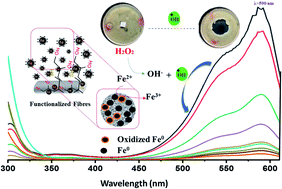Modification of fibrous membrane for organic and pathogenic contaminants removal: from design to application†
Abstract
In this study, a flexible multifunctional fibrous membrane for heterogeneous Fenton-like removal of organic and pathogenic contaminants from wastewater was developed by immobilizing zerovalent iron nanoparticles (Fe-NPs) on an amine/thiol grafted polyester membrane. Full characterization of the resulting polyester membranes allowed validation of successful grafting of amine/thiol (NH2 or SH) functional groups and immobilization of Fe-NPs (50–150 nm). The Fenton-like functionality of iron immobilized fibrous membranes (PET–Fe, PET–Si–NH2–Fe, PET–NH2–Fe, and PET–SH–Fe) in the presence of hydrogen peroxide (H2O2) was comparatively studied in the removal of crystal violet dye (50 mg L−1). The effect of pH, amount of iron and H2O2 concentration on dye removal was systematically investigated. The highest dye removal yield reached 98.87% in 22 min at a rate constant 0.1919 min−1 (R2 = 95.36) for PET–SH–Fe providing 78% toxicity reduction assessed by COD analysis. These membranes could be reused for up to seven repeated cycles. Kinetics and postulated mechanism of colour removal were proposed by examining the above results. In addition, the resultant membranes showed substantial antibacterial activity against pathogenic bacteria (Staphylococcus epidermidis, Escherichia coli) strains studied through disc diffusion-zone inhibitory and optical density analysis. These findings are of great importance because they provide a prospect of textile-based flexible catalysts in heterogeneous Fenton-like systems for environmental and green chemistry applications.



 Please wait while we load your content...
Please wait while we load your content...